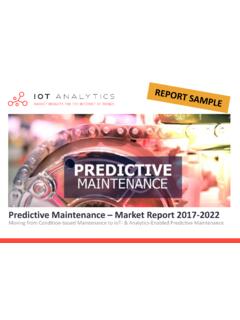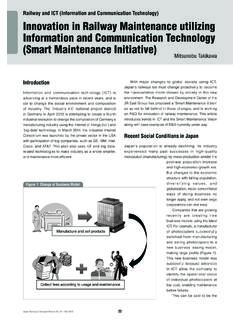Transcription of What is Reliability Centered Maintenance? - …
1 What is Reliability Centered maintenance ? maintenance Reliability - Centered maintenance (RCM) is the process of determining the most effective maintenance approach. The RCM philosophy employs Preventive maintenance (PM), Predictive maintenance (PdM), Real-time Monitoring (RTM1), Run-to-Failure (RTF- also called reactive maintenance ) and Proactive maintenance techniques in an integrated manner to increase the probability that a machine or component will function in the required manner over its design life cycle with a minimum of maintenance . The goal of the philosophy is to provide the stated function of the facility, with the required Reliability and availability at the lowest cost. RCM requires that maintenance decisions be based on maintenance requirements supported by sound technical and economic justification.
2 A Brief History of RCM Reliability Centered maintenance originated in the Airline industry in the 1960 s. By the late 1950 s, the cost of maintenance activities in this industry had become high enough to warrant a special investigation into the effectiveness of those activities. Accordingly, in 1960, a task force was formed consisting of representatives of both the airlines and the FAA to investigate the capabilities of preventive maintenance . The establishment of this task force subsequently led to the development of a series of guidelines for airlines and aircraft manufacturers to use, when establishing maintenance schedules for their aircraft. This led to the 747 maintenance Steering Group (MSG) document MSG-1; Handbook: maintenance Evaluation and Program Development from the Air Transport Association in 1968.
3 MSG-1 was used to develop the maintenance program for the Boeing 747 aircraft, the first maintenance program to apply RCM concepts. MSG-2, the next revision, was used to develop the maintenance programs for the Lockheed L-1011 and the Douglas DC-10. The success of this program is demonstrated by comparing maintenance requirements of a DC-8 aircraft, maintained using standard maintenance techniques, and the DC-10 aircraft, maintained using MSG-2 guidelines. The DC-8 aircraft has 339 items that require an overhaul, verses only seven items on a DC-10. Using another example, the original Boeing 747 required 66,000 labor hours on major structural inspections before a major heavy inspection at 20,000 operating hours. In comparison, the DC-8 - a smaller and less sophisticated aircraft using standard maintenance programs of the day required more than 4 million labor hours before reaching 20,000 operating hours.
4 In 1974 the US Department of Defense commissioned United Airlines to write a report on the processes used in the civil aviation industry for the development of maintenance programs for aircraft. This report, written by Stan Nowlan and Howard Heap and published in 1978, was entitled Reliability Centered 1 As described later in this paper RTM and PdM are often combined under the heading of Condition based maintenance , or CBM. maintenance , and has become the report upon which all subsequent Reliability Centered maintenance approaches have been based . What Mr's Nowlan and Heap found was many types of failures could not be prevented no matter how intensive the maintenance activities. Additionally it was discovered that for many items the probability of failure did not increase with age.
5 Consequently, a maintenance program based on age will have little, if any effect on the failure rate. RCM in the Facility and Utility Arena As with any philosophy, there are many paths, or processes, that lead to a final goal. This is especially true for RCM where the consequences of failure can vary dramatically. Rigorous RCM analysis has been used extensively by the aircraft, space, defense, and nuclear industries where functional failures have the potential to result in large losses of life, national security implications, and/or extreme environmental impact. A rigorous RCM analysis is based on a detailed Failure Modes and Effects Analysis (FMEA) and includes probabilities of failure and system Reliability calculations. The analysis is used to determine appropriate maintenance tasks to address each of the identified failure modes and their consequences.
6 While this process is appropriate for these industries, it is not necessarily the most practical or best approach to use for facilities and utilities systems maintenance . For these systems a streamlined or intuitive RCM analysis process may be more appropriate. This is due to the high analysis cost of the rigorous approach, the relative low impact of failure of most facilities systems, the type of systems and components maintained, and the amount of redundant systems in place. The streamlined approach uses the same principles as the rigorous, but recognizes that not all failure modes will be analyzed. For most facility and utility systems the most economical and efficient approach is to use a combination of rigorous (formal) and intuitive analysis depending on system criticality and failure impact.
7 Failure modes that result in high costs or personnel injury, or where the resultant Reliability is still unacceptable in terms of safety or operational impact still receive the rigorous approach, but all other failure modes will use intuitive analysis. The primary RCM principles are: 1. RCM is Function Oriented It seeks to preserve system or equipment function, not just operability for operability's sake. Redundancy of function, through multiple equipment, improves functional Reliability , but increases life cycle cost in terms of procurement and operating costs. 2. RCM is System Focused It is more concerned with maintaining system function than individual component function. 3. RCM is Reliability Centered It treats failure statistics in an actuarial manner.
8 The relationship between operating age and the failures experienced is important. RCM is not overly concerned with simple failure rate; it seeks to know the conditional probability of failure at specific ages (the probability that failure will occur in each given operating age bracket). 4. RCM Acknowledges Design Limitations Its objective is to maintain the inherent Reliability of the equipment design, recognizing that changes in inherent Reliability are the province of design rather than maintenance . maintenance can, at best, only achieve and maintain the level of Reliability for equipment, which is provided for by design. However, RCM recognizes that maintenance feedback can improve on the original design. In addition, RCM recognizes that a difference often exists between the perceived design life and the intrinsic or actual design life, and addresses this through the Age Exploration (AE) process.
9 5. RCM is Driven by Safety and Economics Safety must be ensured at any cost; thereafter, cost-effectiveness becomes the criterion. 6. RCM Defines Failure as Any Unsatisfactory Condition Therefore, failure may be either a loss of function (operation ceases) or a loss of acceptable quality (operation continues). 7. RCM Uses a Logic Tree to Screen maintenance Tasks This provides a consistent approach to the maintenance of all kinds of equipment. See Figure 1. No Will failure of the facility or equipment have a direct, adverse effect on safety-related or critical operations? Yes Is the item expendable? Can re-design solve the problem permanently and be cost-effective? Yes No No Yes Is there a PdM or real-time monitoring technology that will give sufficient warning of an impending failure?
10 Redesign No Yes Is there an effective PM task that will minimize failures? No Is the test/monitoring cost justified? No Yes Yes Is re-design cost and priority justifed? No Yes Accept Risk Redesign Define PM Task Redesign Figure 1: RCM Logic Tree 9. RCM Tasks Must Be Applicable The tasks must address the failure mode and consider the failure mode characteristics. 10. RCM Tasks Must Be Effective The tasks must reduce the probability of failure and be cost effective. 11. RCM Acknowledges Three Types of maintenance Tasks a. Time-directed (PM) Scheduled when appropriate b. Condition-directed (PdM and real-time monitoring) Performed when conditions indicate they are needed c. Failure finding (one of several aspects of Proactive maintenance ) Equipment is run-to- failure.





